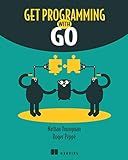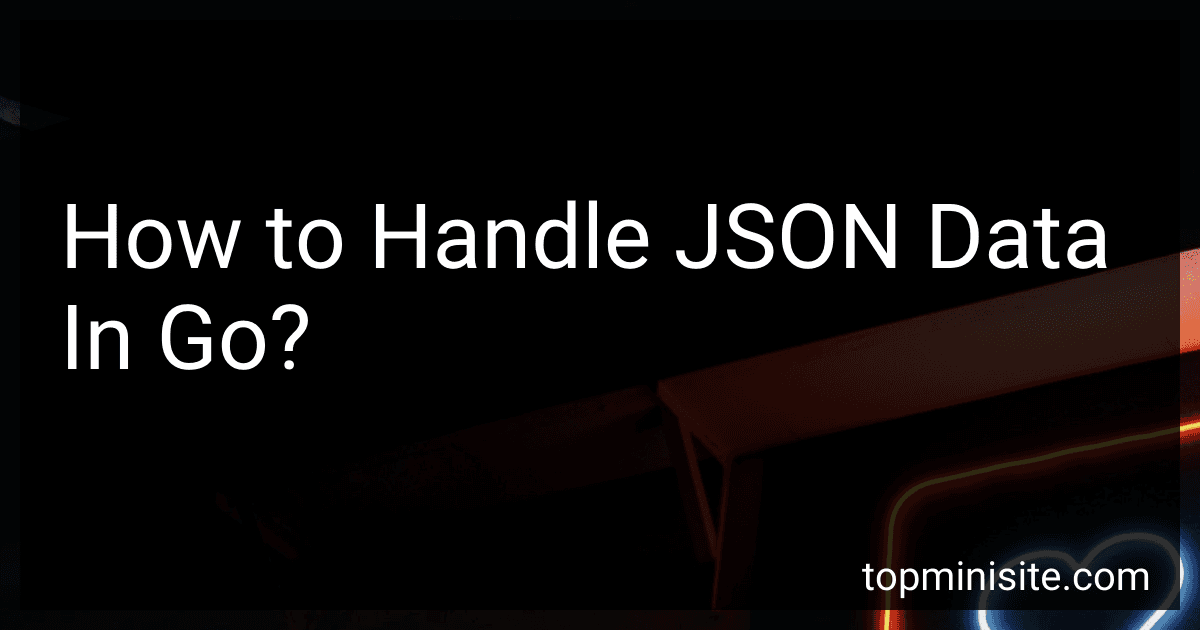Best JSON Handling Tools for Go Developers to Buy in December 2025

Get Programming with Go


JSON (JavaScript Object Notation) is a popular data format used for transmitting structured information between a client and a server. In Go, handling JSON data is straightforward and can be achieved using the standard library package encoding/json.
To work with JSON data in Go, follow these steps:
- Import the encoding/json package:
import "encoding/json"
- Define a struct that represents the structure of your JSON data. Each field in the struct should correspond to a key-value pair in the JSON data:
type Person struct { Name string Age int }
- Marshaling: Convert a struct or any Go data type to JSON. Use json.Marshal() to marshal a Go data structure into a JSON byte array:
person := Person{Name: "Alice", Age: 30} jsonData, err := json.Marshal(person) if err != nil { // Handle error }
- Unmarshaling: Convert JSON data to a struct or Go data type. Use json.Unmarshal() to unmarshal a JSON byte array into a struct or a custom Go data type:
jsonString := `{"Name":"Alice","Age":30}` var person Person err := json.Unmarshal([]byte(jsonString), &person) if err != nil { // Handle error }
- Access JSON data: Once the JSON data is unmarshaled, you can access the structure's fields directly, just like any other Go variable:
fmt.Println(person.Name) // Output: Alice fmt.Println(person.Age) // Output: 30
- Working with nested JSON data: If your JSON contains nested structures, define corresponding structs and access them similarly to access nested fields.
By using the encoding/json package, you can easily handle JSON data in your Go applications, enabling seamless communication with other systems or APIs.
How to unmarshal JSON data in Go?
To unmarshal JSON data in Go, you can use the json package provided by the standard library. Here's an example of how to unmarshal JSON data:
- Define a struct that matches the structure of your JSON data:
type Person struct { Name string `json:"name"` Age int `json:"age"` Email string `json:"email"` Phones []string `json:"phones"` }
The struct fields should have the same names as the corresponding JSON keys. The json:"..." tags specify the mapping between struct field names and JSON keys.
- Use the json.Unmarshal() function to unmarshal JSON data into a Go struct:
import ( "encoding/json" "fmt" )
func main() { // Example JSON data jsonData := ` { "name": "Alice", "age": 29, "email": "alice@example.com", "phones": ["123", "456"] }`
// Unmarshal JSON into a Person struct
var person Person
err := json.Unmarshal(\[\]byte(jsonData), &person)
if err != nil {
fmt.Println("Error:", err)
return
}
fmt.Println("Name:", person.Name)
fmt.Println("Age:", person.Age)
fmt.Println("Email:", person.Email)
fmt.Println("Phones:", person.Phones)
}
When you run this code, it will print:
Name: Alice Age: 29 Email: alice@example.com Phones: [123 456]
The json.Unmarshal() function takes two parameters: the JSON data as a byte slice, and a pointer to the struct where the data will be unmarshaled. If the unmarshaling is successful, the struct fields will be populated with the corresponding JSON values.
How to iterate through a JSON array in Go?
To iterate through a JSON array in Go, you can follow these steps:
- Unmarshal the JSON data into a variable of type []byte or string.
- Create a struct that represents the structure of the JSON array.
- Use the json.Unmarshal() function to unmarshal the JSON data into the struct.
- Iterate through the array elements using a for loop.
Here's an example code snippet that demonstrates how to iterate through a JSON array in Go:
package main
import ( "encoding/json" "fmt" )
type Person struct { Name string `json:"name"` Age int `json:"age"` Email string `json:"email"` }
func main() { // JSON data representing an array of persons jsonData := `[{"name":"John Doe","age":30,"email":"john@example.com"}, {"name":"Jane Smith","age":25,"email":"jane@example.com"}]`
// Unmarshal the JSON data into a slice of Person structs
var people \[\]Person
err := json.Unmarshal(\[\]byte(jsonData), &people)
if err != nil {
fmt.Println("Error:", err)
return
}
// Iterate through the array elements
for \_, p := range people {
fmt.Printf("Name: %s, Age: %d, Email: %s\\n", p.Name, p.Age, p.Email)
}
}
In this example, we define a Person struct representing each person in the JSON array. We then use json.Unmarshal() to unmarshal the JSON data into a slice of Person structs. Finally, we iterate through the people slice using a for loop and print out each person's details.
What is JSON data?
JSON (JavaScript Object Notation) is a lightweight data-interchange format that is easy for humans to read and write and easy for machines to parse and generate. It is a commonly used format for storing and transmitting data between a server and a client, or between different parts of an application. JSON data is composed of key-value pairs, where the keys are strings and the values can be strings, numbers, boolean values, arrays, or other JSON objects. It is often used in web development and API communication.
How to consume JSON web API in Go?
To consume a JSON web API in Go, you can follow these steps:
- Import the necessary packages:
import ( "encoding/json" "io/ioutil" "log" "net/http" )
- Define a data structure that matches the JSON response you expect to receive:
type Response struct { Name string `json:"name"` Email string `json:"email"` // Add more fields as necessary }
- Make an HTTP request to the API endpoint using the http package:
url := "https://api.example.com/data" res, err := http.Get(url) if err != nil { log.Fatal(err) } defer res.Body.Close()
- Read the response body:
body, err := ioutil.ReadAll(res.Body) if err != nil { log.Fatal(err) }
- Unmarshal the JSON response into your defined data structure:
var response Response err = json.Unmarshal(body, &response) if err != nil { log.Fatal(err) }
- Use the data from the response as needed:
log.Println("Name:", response.Name) log.Println("Email:", response.Email)
Make sure to handle any errors appropriately by logging or returning them as needed.
Remember to replace the URL in step 3 with the actual API endpoint you want to consume, and update the Response struct in step 2 to match the JSON structure of the response you expect to receive.
What is a JSON file?
A JSON (JavaScript Object Notation) file is a lightweight data interchange format. It is used for storing and transmitting data in a structured format, primarily between web servers and web applications or between different parts of a single application. JSON files are easily readable by humans and machines, as they are written in a text format. They consist of attribute-value pairs, where data is represented in key-value pairs enclosed in curly braces { }. Additionally, arrays and nested objects can also be included in a JSON file. JSON has become a popular format for APIs (Application Programming Interfaces) to exchange data as it provides a standardized way to represent and transfer information.
How to manipulate JSON data in Go?
In Go, you can manipulate JSON data using the built-in encoding/json package. This package provides functions to marshal (encode) Go data structures into JSON, and to unmarshal (decode) JSON data into Go data structures.
Here's an example of how to manipulate JSON data in Go:
- Import the encoding/json package:
import "encoding/json"
- Define a Go struct that represents the structure of the JSON data:
type Person struct { Name string `json:"name"` Age int `json:"age"` Address string `json:"address"` Email string `json:"email"` }
- Marshal Go data to JSON:
person := Person{Name: "John Doe", Age: 30, Address: "123 Main St", Email: "john@example.com"} jsonData, err := json.Marshal(person) if err != nil { // handle error }
// jsonData is a byte slice containing the JSON data
- Unmarshal JSON to Go data:
jsonString := `{"name":"Jane Doe","age":25,"address":"456 Elm St","email":"jane@example.com"}` var person Person err := json.Unmarshal([]byte(jsonString), &person) if err != nil { // handle error }
// person now contains the unmarshaled JSON data
- Manipulate the Go data structure as needed.
- Marshal the modified Go data back to JSON, if necessary:
modifiedJSONData, err := json.Marshal(person) if err != nil { // handle error }
// modifiedJSONData is a byte slice containing the modified JSON data
These are the basic steps for manipulating JSON data in Go. You can use the encoding/json package's functions to handle more complex scenarios, such as handling arrays, nested objects, and custom marshaling or unmarshaling logic.
